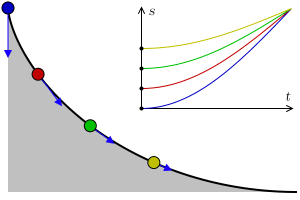The Cycloid and the Pendulum Clock
What is a cycloid?
If a point on a wheel is marked and the wheel is rolled on a flat surface, the marked point generates a curve. This curve is called a cycloid. At first, the curve seems ordinary — Galileo suggested that that it would be a nice arc for a bridge — but it has a lot more interesting properties and uses than that.

Interesting Properties of a Cycloid
In 1634, Frenchman Gilles Persone de Roberval showed that the area under one arc of the curve is thrice the area of the generating circle, but did not publish his findings. When Italian Evangelista Toricelli published the same result in 1644, he was accused by the former of plagiarism. Aside from this bitter bickering, numerous conflicts among Geometers were created by the controversial curve, and because of that, it has been called as the “Helen of Geometers.”

Four points run over a cycloid from different positions, but they arrive at the bottom at the same time. The blue arrows show the points’ acceleration along the curve. On the top is the time-position diagram.
In 1658, Christopher Wren computed the length of an arc of the cycloid to be four times the the diameter of the generating circle.
Another interesting property of a cycloid is that when an object, say a ball, is released even from different “heights” on a cycloid (assuming there is no friction), they will reach the bottom of the curve at the same time.
Application in Real Life
One of the practical applications of the cycloid is the pendulum clock. During the infancy of pendulum clocks, clock makers discovered that a circular path followed by a pendulum is not isochronus and therefore would keep a different time depending on distance of the swing. It was discovered by Christian Huygens that a perfect pendulum can be created using a cycloid .
The article titled Things are Seldom What They Seem has a more detailed explanation regarding this concept of you are interested.
Image Credit: Wikipedia